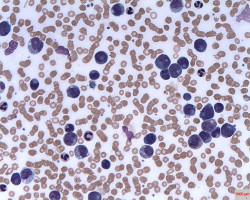
Every year, nearly 11,000 Americans die of acute myeloid leukaemia (AML), a blood cancer that affects mainly older adults.
While most patients initially respond to chemotherapy, more than half of those who respond will eventually relapse as the cancer cells develop resistance to treatment.
In a new paper published in Cell Research, a team of scientists led by Pier Paolo Pandolfi, MD, PhD, Director of the Cancer Center and Cancer Research Institute at Beth Israel Deaconess Medical Center, reveal vulnerabilities in a subset of AML that could serve as the foothold researchers need to overcome resistance to therapy.
"There is an acute need to develop rational combinations to treat disease and overcome resistance that arises in response to therapy," said Pandolfi. "By providing a critical understanding of the mechanisms underlying the disease, we identified a therapeutic strategy for treatment of this type of AML."
About 20 percent of AML cases involve a mutation in a key metabolic enzyme called IDH.
Using a previously published genetically engineered mouse model as well as human cell line in vitro and in vivo models for AML with this mutation, Pandolfi and colleagues identified key processes these cancer cells use to develop - or evolve - drug resistance in response to therapies.
By following the pathway to resistance in a step-by-step manner, the scientists - including first author Vera Mugoni, PhD, a postdoctoral research fellow in the Pandolfi lab - identified critical vulnerabilities that researchers can potentially exploit for therapeutic benefit in all stages of the disease's evolution.
Moreover, the team demonstrated that a combination of drugs already in use for treatment of another type of leukaemia worked equally as well against this form of AML in both an in vitro and in vivo setting.
"The molecular processes that are frequently required to promote resistance to therapy leave tumours vulnerable in other areas," said Mugoni.
"In the case of AML with mutation to IDH enzymes, both metabolism and differentiation pathways were altered, exposing vulnerabilities that become exacerbated as the leukaemia evolves, and for which we already have approved agents that can be utilised."
Another form of leukaemia known as acute promyelocytic leukaemia (APL) was once a fatal diagnosis.
It is now considered a curable disease, thanks to researchers including Pandolfi, who demonstrated that arsenic trioxide (ATO) was effective against APL in combination with another drug called all-trans retinoic acid (ATRA).
In the current study, Pandolfi and colleagues tested the combination in both the mouse model of AML with IDH mutation and in human AML cells.
They determined that, while the drugs target different vulnerabilities in the different forms of leukaemia, the combination proved "powerfully and exquisitely effective" against this subset of AML.
"With my lab's previous discovery that all-trans retinoic acid and arsenic trioxide is curative in the treatment of acute promyelocytic leukaemia (APL), witnessing the translation of this same therapy to possible therapeutic approaches for other forms of AML is extremely rewarding," said Pandolfi.
Pandolfi adds his team is currently working to develop clinical trials to evaluate the ATRA and ATO combination for treatment of AML with mutation in IDH enzymes at multiple centres throughout the United States and beyond.